
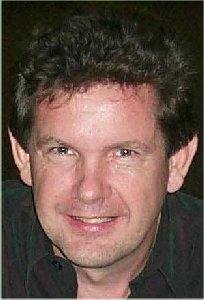 Hi, my name
is Scott Balson.
Hi, my name
is Scott Balson.
When I was just seven years old my father gave me an Egyptian 20 Piastre coin dated 1916 that he had acquired during the second world war - a coin that he had always cherished. I will never forget the moment that dad put the coin in my hand and said, "Son it's yours".
I looked down at the coin which filled the palm of my young hand. It was dirty but special. He told me how he had kept it as a second world war souvenier while fighting for the Allies in Egypt. To me it was like a family heirloom - it was also the foundation for my interest in numismatics and collecting in general.
In my moments of intense loneliness at boarding school the coin became my trusted friend. As a friend I carefully polished the coin with Silvo to remove all its visible blemishes and in doing so destroyed its numismatic value but, to me, this piece remains my most treasured possession rated above the Veld and Burger Ponds, Griqua Pond notes and other rare pieces my family trust holds. After all it was the catalyst, the spark that created everything you see here, research, books, rare notes and coins, documents and history. (Image of this coin below).
As my parents, who had left Tanganyika in 1964 with little more than their clothes, could not afford me the University education provided to my elder (and only sibling) brother I moved into banking after leaving school.
In the mid-late 1970s and early 1980s I worked for Barclays National Bank in Natal, South Africa. My interest in numismatics, thanks to this old Egyptian coin, grew into a hobby through my related work at the bank. I started collecting the old South African silver tickeys, six pences, shillings etc.. that occasionally came across the counter.
It
is important to note that I have always been a little outside mainstream
numismatics which is now largely represented by wealthy investors looking
for an alternative way to making a "quick buck" through a "hobby". To me
the relative scarcity and related value of a mainstream coin like the 1931
South African 3d (tickey) or 1930 Australian penny is ludicrous when one
considers far more important and historically significant numismatic pieces
that lie forgotten because no one has bothered to dig into their history.
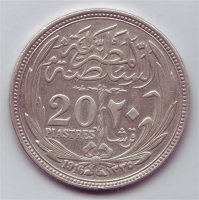
Image right: the polished coin that stirred my initial interest in coin collecting in 1963 when I was just a boy.
On this web site coins and bank notes currently held by my family trust,
the Balson Holdings Family
Trust*, like the Veld Pond,
Griqua Een Pond note and German East
African "siege" 15 Rupee Tabora Pound, are
equated numismatically equal or lower than extraordinary and
historically living trade tokens like the
Strachan and Co and F
C Larkan pieces - despite these tokens being worth a tiny fraction
of the mainstream pieces' "investment value" at this time. (Since
this web page has been established the relative investment value of these
tokens has far outpaced any other traditional numismatic
pieces). After 25 years of hands-on research and collecting a
unique set of related books I have been
fortunate to be able to re-write much of the early history of numismatics
in South Africa (ie pre-1900) - demonstrating that revisionism of the mainstream
media's slant and, in particular, the accepted "history" of numismatics is
healthy and good for a thinking society.
* The Balson Holdings
Family Trust holds a number of unique and valuable collections.
Like the old Egyptian coin my father gave me over forty years ago the story
below is an integral part of this evolving fabric of my life - thus my special
interest in coins and notes that have been minted or printed in the most
extreme of circumstances, during times of war or isolation from the mainstream
of society.
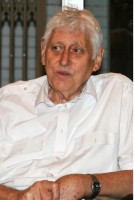
Image right Prof Clive Graham who passed away in June 2010
During my journey in numismatics in the 1970s I got to meet some amazing people like Phil Cassere who lived in Pietermaritzburg and chaired the local numismatic society; the introverted and modest Dr Clive Graham from the University of Natal who co-wrote the book on the Strachan and Company trade tokens; the well known and respected numismatist and medical doctor Dr Frank Mitchell; and, of course, Dr G P Theron (another medical doctor) - the man who, after Maynard, wrote the first authoratitive work on South African trade token coins in 1978. More recently I have been fortunate to use modern communication systems like the Internet to interact with serious numismatists like Rege Podraza, Allyn Jacobs, Michael Laidlaw, Han Eybers and Daniel van der Laan. I have been able to communicate with Cecil le Fleur, a direct descendant of the Griquas, the Griqua Museum in Kokstad and present my research to Krause, Spink and the National Numismatic Society of South Africa. As a result Spink in London have now accepted my findings that the trade tokens of Strachan and Co are South Africa's first widely circulating indigenous coinage and that the Griqua Town coins never circulated in 1815/16.
But let's get back to the story at hand...
Return to the top of this page
This is an accurate account of how I acquired the Strachan and Co and F C Larkan trade tokens - the former now being recognised as South Africa's most important non-boer currency of the 1800s and South Africa's first widely circulating currency. I have also included links on this web site to some of the Balson Holdings Family Trust's more important exonumia collections and coin collections.
During 1976 I was transferred from Greytown to Ixopo (Zulu word - onomatopoeia for ich-o-po - after the sound of cattle's hooves sinking in and being pulled out of the marshy lands found around the town) by Barclays National Bank. From mid December 1976 I started work as the agency teller in the small bank agency at the small trading town of Umzimkulu. The agency was just large enough to hold my cash canister, me and an African who looked after opening and closing savings accounts. We stood behind a wide counter with a head-high timber and glass divider separating my tiny teller's cubicle from the back office. The public area across the counter was secured by a couple of useless metal bars and dominated by a large door which, when open, would allow two people to enter side by side - one for the banking queue and another for enquiries. In total the bank agency fitted about six people at a squeeze - including the enquiries clerk and myself. It was not much larger than a toilet which became unbearably hot in summer as we toiled under a corrugated iron roof. The agency was always busy while many days would go by without a white person coming in. The Africans in the queues were always very well behaved even though they sometimes had to wait hours outdoors in the sun to be served when it was government payday.
The town of Umzimkulu is some 20km from Ipswich and located on the banks of the wide, brown and sluggish Umzimkulu river which snakes down from the Drakensberg in the west on its way to the sea. This town was once, in the 1800s, the trading gateway between the Griqua people of Kokstad in East Griqualand (formerly Nomansland) and the city of Pietermaritzburg in Natal. In those days a small hand-pulled ferry was the only form of transport across the wide Umzimkulu River. One hundred years on things were very different and a large bridge now straddled the Umzimkulu river but the large chain of Strachan and Co trading stores were still dominant in the new homeland of Transkei and the dirt roads had, if anything, deteriorated around the shanty town of huts and shacks that were the standard in this dusty African backwater.
On my second day at the Umzimkulu agency a stocky, shortish white man in his late 60s pushed his way into the small bank agency. The Africans in the queues moving aside as they said "Hau baas"... meaning "Excuse me boss". They all seemed to know and fear him, I couldn't understand why he seemed harmless enough. I looked closely at this elderly man as the African I was serving moved aside for him. His rugged sun burnt face was dominated by a large grey beard and receding grey hair tinged with a coppery red. Pale skin does not travel well under the African sun. He lifted a large canvas bank bag full of money onto the counter.
"I'm sorry but you will have to join the queue," I said pointing at the line of about twenty natives and coloureds standing patiently and nervously watching this whiteman push in in front of them.
He did so without saying a word. I had just sent the Transkei's wealthiest man, Kenneth Wallace Strachan, grandson of the legendary Donald Strachan, to the back of a long queue with the bag of Strachan and Company day's takings in his hands.
There was an urgent knock on the window separating the enquiries clerk from my cubicle as the whiteman turned and left. My African assistant stuck his head over the top of the dividing wall and whispered, "Hau baas you have just lost your job. That Mr Strachan." There was obvious fear in his eyes - his unusual action in communicating with me seemed to seal my fate..
I watched as Mr Strachan joined the end of the queue and stood waiting in the hot African sun, the natives in front of him were stunned, they whispered, joked and looked nervous. Twenty minutes later he came to the counter and introduced himself.
"Hi, I'm Ken Strachan. Thanks for doing that," he offered. "I have to realise that times are changing - what with the homeland policy and East Griqualand now being the independent state of Transkei. I won't be coming in again I will just send one of my staff."
"I'm sorry to have to do that," I replied. "By the way with all your stores you must have quite a bit of the old silver currency - I collect coins and would love to buy them off you."
His eyes brightened. "Son, I have something far more interesting than that. We produced our own coins that were accepted all over the Transkei and even in southern Natal as currency for over fifty years!"
In April 1977 I gave a talk to the Pietermaritzburg Numismatic Society about the Strachan and Co tokens, at the next meet in May 1977 Dr Clive Graham approached me about producing a booklet on the fascinating coins. I happily agreed.
Days later, in June 1977, I took up Ken Strachan's offer to come and see the large bounty of tokens in his storage area. There were twenty to thirty small black metal canisters about 8 inches by 6 inches by 6 inches covered in thick layers of dust that were full of thousands and thousands of uncatalogued Strachan and Co tokens. The tokens had never been viewed by numismatists and had remained untouched in the boxes for nearly fifty years. They had been long forgotten but stored almost as a tribute to the marketing strategy that had heralded the company's incredible growth one hundred years before.
Ken Strachan, who's lineage can be seen at this link, allowed me to categorise the entire stock of tokens - this involved taking a few metal canisters at a time home and carefully bathing all the tokens in my bath to remove layers of dust and grime that had collected over the years. This task took six months working several hours every night cataloguing and, in the process, discovering and recording for the first time the extra set of "in goods" tokens. By the time I had completed the task neither the bath nor my towels I carefully dried the coins on were ever the same again and the room mate I had shared the house with had lost his sense of humour - completely. While cataloguing the Strachan and Co tokens I came across a small canvas pouch containing about 100 F C Larkan tokens. The pouch was sitting on top of hundreds of the brass S&Co tokens in one of the black metal canisters. Ken Strachan had no interest in them saying that they were a relic of the past when the Strachan empire took over the failing stores run by Mrs F C Larkan. He said I could keep them.
Ken Strachan also spent hours with me in late 1977 and early 1978 giving me the broad historical background
on issues such as the Mountain Home set, access to old letter books and the
like. A member of his staff uncovered the key diary note by Douglas Strachan refering to the S&Co coins being released in the early 1870s. Much of this information, photos and images are contained in the book
"Kence, the trade tokens of Strachan and
Co". At this time he confirmed to me that in 1874 the first set of S&Co were launched - ie on the same day the company opened its doors. Donald Strachan and and Charles Brisley, the partners, being the most influential men in the region.
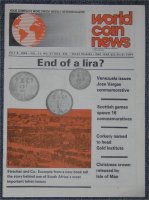 The result was the aforesaid book researched and published with the assistance
of (the late) Prof Clive Graham, a well-known numismatist and academic based in
Pietermaritzburg.
The result was the aforesaid book researched and published with the assistance
of (the late) Prof Clive Graham, a well-known numismatist and academic based in
Pietermaritzburg.
We produced 1,000 copies - I later bought out Prof Graham's share in the publication not long after they were printed. Ken Strachan was delighted with our efforts and bought 30 copies of the book - to distribute to family, friends, the Killie Campbell Library in Durban and the then Prime Minister of the Transkei. (See his letter: page 1, page 2) Two years later over 800 of the books were lost in a fire on my farm in the Drakensberg leaving me with just 30 copies from those I had already sold.
In July 1986 World Coin News carried a lengthy article on the Strachan and Co tokens. (See image right). That year Ken Strachan's stores were bought out by the South African government and he retired to Pietermaritzburg taking the tokens with him in canvas bank bags. Ken died some years ago. Unfortunately the thousands of tokens that made up those catalogued by me back in 1977 have disappeared but many new sizable finds of Strachan & Co tokens have come to light in recent years.
Ken Strachan allowed me to keep several sets of the tokens in return for the work in cataloguing them and as recognition of the research work that I did on the book "Kence, the trade tokens of Strachan and Co".
In 1984 the Strachan and Co empire was liquidated after East Griqualand was turned into the independent homeland of Transkei under the Apartheid regime. Ken Strachan took the tokens counted by Scott Balson in 1977 with him and had them melted down - donating the proceeds of the brass to a church.
From the attached scans you can see that Scott Balson offered to buy the entire stock of Strachan and Co coins from the firm in 1977 but, sadly, this offer was declined. See scan of Margaret Rainier'e letter dated 7th September 1977 page one and page two.
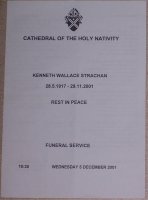 Ken Strachan passed away on 29th November 2001, aged 84
years, we extend our sincerest sympathies to his family - he was a very special
human being.
Ken Strachan passed away on 29th November 2001, aged 84
years, we extend our sincerest sympathies to his family - he was a very special
human being.
The image on the right is an orginal copy of the late Ken Strachan's funeral service held in Pietermaritzburg.
Since the 1980s I have expanded my interest to pre-1923 South African coins as I find the more recent pieces, quite honestly, ho-hum. So what if only a small number of tickeys were minted in 1931... what story do these pieces have to tell? Raw numismatics is discovery, research and appreciation. The investment value flows from this... an important part of this is research and over the last 25 years I have established the finest collection of Griqua-related books in any private collection (yes, I have written a couple of these books including - "The Griquas of South Africa and their money which destroys the romantic fallacy about the Griqua Town coins being South Africa's first circulating currency and "Children of the Mist" - the book endorsed by the Griqua National Council and now used by the Griqua as their historical record. This unique collection of books includes three copies of Dower's 1902 book with the extremely rare Een Pond Griqua note - today worth US$5,000 a piece.
I have also collected other early South African Coins including Paul Kruger (pre-Boer war) pieces and a couple of the extremely rare Veld Ponds - because of their history related by time and circumstance. However, the Strachan and Co pieces remain the finest investment in South African coinage today.
Return to the top of this page
My interest in German East African coins and bank notes issued von Lettow-Vorbeck circa 1916 arises from my childhood.
I was born and raised in Tanzania (formerly known as Tanzania and German East Africa prior to the end of World War One. I grew up in the the small town of Iringa in the Southern Highlands of Tanganyika - flying to school in South Africa in the early 1960s as education in East Africa was limited.
The photo right is of the Ocean Road Hospital in Dar-es-Salaam built by the Germans in about 1897 - and where I was born. It still stands today.
My interest in
Fijian coins
and bank notes arises out of involvement in the travel business
FijiBure.com.
Return to the top of this page
My special interest in the coins of the Griqua people has led to another
project under development - a book which looks at the history of the Griqua
Nation. The story behind the book "Children of the Mist" can be found
at this link.
Return to the top of this page